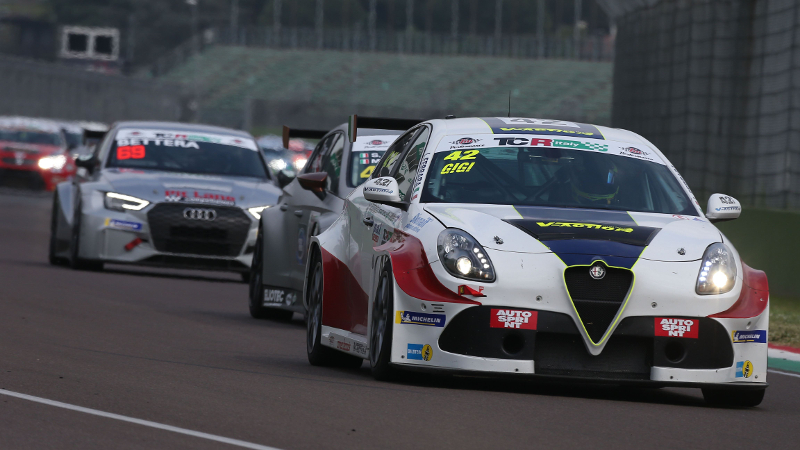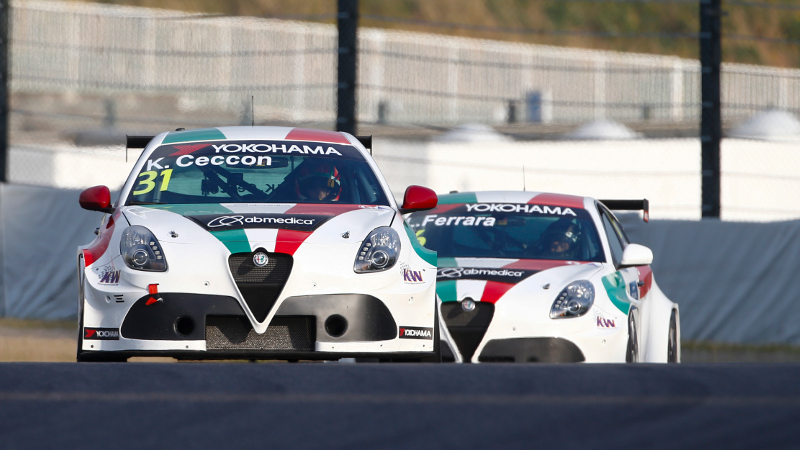The Romeo Ferraris outfit, responsible for building the Alfa Romeo Giulietta cars in TCR, has reported a significant upturn in car sales, but at the same time confirmed it will not be expanding to four cars in FIA WTCR.
Through the satellite Team Mulsanne operation, Romeo Ferraris ended the 2018 season in strong form, with Kevin Ceccon taking a memorable win for the car in the first race in Japan, and following it up with a podium in the third race.
Such was Ceccon’s performance – having only joined the team at the mid-point to replace Gianni Morbidelli – that he ended the year 14th overall in the drivers’ standings, despite only competing in half the 30 races scheduled.
The real upturn began at the Slovakiaring in July, when both Ceccon and Fabrizio Giovanardi took top ten finishes for the car in WTCR for the first time.
“The real step forward for us was Slovakia,” said Remeo Ferraris Operations Director Michela Cerruti. “People realised the car could be in the top ten of a world championship, then in the top five and then in the victory like it was in Suzuka.
“We got many, many requests from that point on, both from people who were half-convinced to take the car, but also from people who had never heard about the Giulietta, but found out that it was existing after Suzuka and that it could be competitive.”
Five Giuliettas were regularly competing in 2018, but Cerruti expects this number to treble in 2019 after the outfit’s success.
The car took seven wins in both WTCR and TCR Italy in 2018, adding to the three victories scored in the TCR International Series in 2017.
“This year we have sold five cars in ten days, including to customers in Australia, Japan and Denmark,” added Cerruti. “We have cars in China and two cars in the IMSA championship in the US. Last year they did only a couple of races in the US but now they have decided to enter the two cars they have for the full IMSA championship.
“That means the cars can be seen and now we have cars in strategic places. I have been pushing to have customers to touch all the parts of the world. Other countries are getting interested, the TCR platform is so big.”
Cerruti admits that the small nature of the operation means it has presented its own challenges for the Italian company.
“We build the cars but at the same time we race the cars and then we also take care of the customers we have around the world.
“From mid-2018, when the cars started to be competitive in the WTCR, the situation changed quite a lot with the interest.
“But we are not 100 people, we are something like 16 with ten people working all the time doing everything. We are busy 100 per cent, 365 days a year.”
“Potential customers like the fact we are small and do something with passion. At first some results were lacking, we had less cars on track, so we had less chances to make a result.
“For the first half of 2018 it was hard. We needed to show the car could be quick in WTCR, because being quick in TCR Italy, for example, was not enough to sell the car because people expect us to be quick in Italy.
“To win in WTCR was like an ant fighting against a giant. If people can see you consistently in the top ten it has a huge value, the same value as winning 10 races in Italy. That’s because WTCR is a different level, it’s the reference point for everyone to understand which car is competitive or not.”
The expansion does, however, mean that Romeo Ferraris will not be expanding to four cars in WTCR this year as originally planned.
“We wanted to grow to four cars in WTCR and I would have done it if I had the cars at the workshop,” said Cerruti. “I was sure that I would have these cars at the workshop but they have gone to customers.
“From one side I’m happy, but from another side I am a little bit disappointed because we wanted to grow as a team and have more chances to make points and victories in WTCR. But we have to find the right balance between selling cars and racing them.
“We have two different kinds of priority which are exactly on the same level. One is to go on making the Alfa win and have good results overall in the WTCR because that’s the place where we have the biggest feedback and also from the media point of view. It’s the most competitive TCR level in the world.
“If we can be competitive then this will give motivation to our customers around the world because they can see if we win they are confident to have a winning car and they are much more motivated. If we don’t win they feel it.
“The other first priority is take care of our customers. Even if it’s sometimes not easy because they are on the other side of the world, we have created online systems and online strategies to be always with them even when we are physically in another place.
“It’s nice because we establish a very good relationship and a very good level of communication with them. We are all racing together all of the time.”

Cerruti added that the company is planning to introduce some new developments to the Giulietta for the coming season.
“We will have something new. We have learned a lot from last season. We ended 2017 with a winning car in TCR International but we started in WTCR with a car that was not competitive enough, but we recovered during the season.
“This time we are expecting the level to get higher and higher because there will be improvement from everyone. We do not want to be unprepared like we were last year because this year will be another step.
“In 2018 had no experience with Yokohama, this time we have. I don’t want to say we will win the first race because I have to be realistic as the competition will be crazy high and the level of the drivers is incredibly high.”

